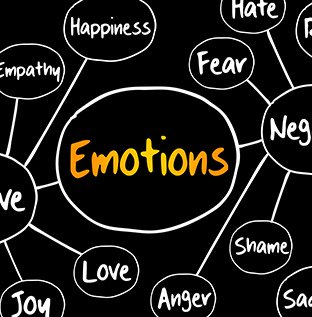Emotions as a Healthcare Concern – Part 1.

What stirs our souls when we watch a glorious sunrise, depresses our mood when facing a disappointment, enflames our passion when we see injustice, or sickens us when we see repulsive behavior? Emotions do. But what are emotions? Where do they come from? Did we learn them or were they inborn? Are they the product of thought or of something else? Can we control them or are they uncontrollable? How do emotions influence our choices and decisions?
For centuries, prophets, poets, and philosophers have posed these questions. Modern-day psychologists and neurologists ask the same questions and have begun to apply scientific research to understand the origins and functions of emotions. Though studies have revealed something about the anatomy and physiology of emotions, scientists have yet to agree on a single, comprehensive theory to explain the capacity of living creatures to experience and express this enigmatic thing we call an emotion (de Sousa, 2007).
Though scholars hold different views regarding a philosophical theory of emotions and the capacity to experience and express emotions, they agree on the following characteristics:
- Emotions are conscious phenomena—that is, people are aware of them.
- Emotions are more consistently demonstrated than other conscious states, such as fatigue.
- Emotions vary in several dimensions, such as intensity, type, and range.
- Emotions are reputed to be antagonists of objective, rational thought.
- Emotions play an indispensable role in determining the quality of life.
- Emotions contribute significantly when we define priorities in our lives.
- Emotions play a crucial role in the regulation of social life.
- Emotions protect us from excessively narrow rational thought.
- Emotions hold a central place in moral education and moral life.
(de Sousa, 2010)

Neurologists have found that emotions are produced by a complex organization of the brain called the limbic system. The word limbic comes from the Latin word limbus, meaning “edge” or “border,” though its major structures are located in the center of the brain. The limbic system is the area of the brain that becomes active when humans experience an emotion from a past or present event. The system influences the formation of memory and integration of emotional states with physical sensations (Boeree, 2009).
Using perceptions and thoughts, the structures of the brain’s limbic system store and retrieve information from memory, generate emotions, and provide feedback about appropriate social behavior.
However, identifying and naming these structures is just the beginning. We need to know much more in order to understand emotions. Specifically, we need to define what we mean by emotions; then we need to learn their functions, numbers, qualities, intensities, and combinations. Most important, we need to learn how to manage our emotions.
WHAT ARE EMOTIONS?
An emotion is “a complex sequence of events having elements of cognitive appraisal, feelings, impulses to action, and overt behavior; it is a feeling that accompanies an adaptive behavior for survival” (Plutchik, 1991).
Studies of the emotions have identified four positive and four negative emotions relative to the pleasure or displeasure they bring.
| EMOTIONS | |||
| Primary Emotions | Degrees of Feeling | Life-Preserving Functions | |
| Acceptance (love, trust) | Adoration-acceptance-toleration | Incorporation of sustenance | |
| Positive | Anticipation (hope) | Vigilance-anticipation-hope | Exploration of the environment for safety |
| Surprise (shock) | Amazement-surprise-distraction | Orientation to an unexpected and possibly dangerous event | |
| Joy (happiness) | Ecstasy-joy-pleasure | Reproduction of the species | |
| ————- | ———————— | ———————————– | —————————————————————- |
| Fear (terror) | Terror-fear-apprehension | Protection from harm | |
| Negative | Anger (wrath) | Rage-anger-annoyance | Destruction of the enemy |
| Disgust (revulsion) | Loathing-disgust-boredom | Rejection of whatever may be harmful | |
| Sadness (sorrow) | Grief-sadness-pensiveness | Reintegration to wholeness |
Adapted from Plutchik, 1991; Lazarus, 1991.
Emotions serve life-preserving functions for the survival of the human species, including:
- Incorporation of what is helpful
- Exploration of the environment
- Orientation for the sake of safety
- Reproduction for continuation of the species
- Protection against harm
- Destruction of danger
- Rejection of what may be harmful
- Reintegration to wholeness when wounded
An emotion is “a complex sequence of events having elements of cognitive appraisal, feelings, impulses to action, and overt behavior; it is a feeling that accompanies an adaptive behavior for survival”

An emotion is a chain reaction beginning with the perception of a stimulus event, followed by cognition (appraisal), then feeling, then impulse to act, and finally action. All of this occurs to increase the likelihood of survival. These steps are illustrated as follows:
- Stimulus event: A disheveled man steps off the elevator on the pediatric unit of the hospital, carrying a gun. He approaches the nurses’ station and says, “I’ve come to get Danny. He’s my son. You can’t have him and neither can his mother!”
- Perception: The nurse sees the man’s crazed facial expression and the gun and hears his order.
- Cognition: She thinks, This man is dangerous. He could hurt me and the patients. He may be experiencing PTSD (posttraumatic stress disorder).
- Feelings: The nurse feels intense fear. The emotion serves a survival function, mobilizing her mind and body to protect itself.
- Impulses to action: She wants to escape from the danger. Epinephrine from her adrenal glands increases her heart rate and blood floods her body. She remembers the emergency button beside the telephone on the counter.
- Action: The nurse presses the emergency button, lowers her voice, and speaks to the man as calmly as she can manage.
Each emotion has varying degrees of intensity. For example:
- Annoyance → Anger → Rage
- Boredom → Disgust → Loathing
- Pensiveness → Sadness → Grief
- Apprehension → Fear → Terror
- Distraction → Surprise → Amazement
- Pleasure → Joy → Ecstasy
- Hopefulness → Anticipation → Vigilance
- Toleration → Acceptance → Adoration
In addition to intensity, emotions often combine to form more complex emotions, such as:
- Disappointment = Sadness, surprise
- Jealousy = Sadness, anger, fear
- Remorse or guilt = Sadness, disgust
- Contempt or blame = Disgust, anger
- Shame = Fear, disgust
- Submissiveness = Fear, acceptance
- Awe = Fear, amazement
- Love and trust = Joy, acceptance
- Optimism = Anticipation, joy

Although emotions may be called positive or negative, in themselves they are neither good nor bad. Even so, the behavior people exhibit and the action they take when they experience emotions may be harmful or helpful to themselves or others. For example, unmodulated joy may become mania; uncontrolled anger may beget violence and cruelty; unresolved sadness may lead to depression and suicide; and unfocused or inappropriate fear may become anxiety, phobia, and paranoia. For this reason, to live a balanced life people must learn to manage their emotions, accepting their reality but controlling the actions they take.
REFERENCES:
Boeree, CG. (2009). The emotional nervous system. Retrieved September, 2011, from http://webspace.ship.edu/cgboer/limbicsystem.html.
de Sousa R. (2010). Emotion. The Stanford encyclopedia of philosophy. Retrieved March 10, 2011, from http://plato.stanford.edu/archives/2011/entries/emotion/.
Lazarus RS. (1991). Emotion and adaptation. New York: Oxford University Press
Plutchik R. (1991). The emotions: Facts, theories, and a new model (rev. ed.). Lanham, MD: University Press of America.
Sign up for our newsletter email list and like us on Facebook and Instagram to be among the first to know about all our special discounts and offers!
About Wild Iris Medical Education:
Wild Iris Medical Education, Inc., is a privately held, woman-owned company providing online healthcare continuing education. In 1998, we began offering online ANCC-accredited nursing continuing education courses and since then have expanded to provide CEUs for occupational therapists, physical therapists, paramedics, EMTs, and other healthcare professionals.
Accredited and Approved Nationwide.
High-quality CEU Courses since 1998.

Join Our More Than 750,000 Satisfied Customers Now!
High-quality, accredited, evidenced-based continuing education courses in an easy-to-use format designed for learning, from Wild Iris Medical Education. We’ve been providing online CE since 1998.



